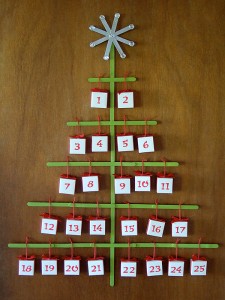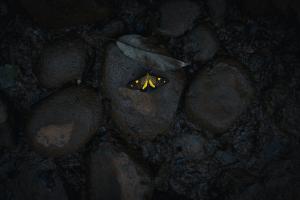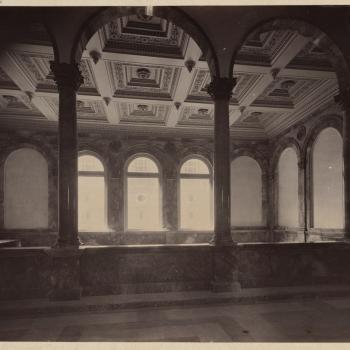 As a child, I was somewhat confused by the partridge in the pear tree and by Advent calendars. I liked both—especially the calendars, with their stiff little paper tabs opening up to an image of a toy or a bird or a tree for each day—but I didn’t understand the numerology.
As a child, I was somewhat confused by the partridge in the pear tree and by Advent calendars. I liked both—especially the calendars, with their stiff little paper tabs opening up to an image of a toy or a bird or a tree for each day—but I didn’t understand the numerology.
Advent calendars were calendars, but they didn’t last the entire month. They ended at twenty-four, the payoff of the often-arch-shaped double door opening up to reveal a honey-tinted scene of the Christ child in the manger.
It made sense, even though I wondered about the remaining seven days of December. Anticipation ended on Christmas morning, didn’t it? My brother or I woke the other up, so neither would be first, and went down the hall to wake our parents, and opened our stockings on Mom and Dad’s big California king before heading down to the tree and the fun of eating coffee cake in the living room amongst torn wads of wrapping paper.
Christmas ended, inevitably, on the drive home from my grandfather’s, during which my parents barely spoke, my father having had too much to drink and often embarrassing (her word) my mother at the dinner table with an outburst directed at my aunt (a lush, his word), my uncle (an idiot), or my cousin (a long-haired ingrate).
The next day would be the twenty-sixth: no more little presents, no more stiff paper doors, no more anticipation, no more baby in the manger.
The Advent calendar got it right: the fun was over, until next year. So what was with this business of the gifts increasing and increasing, all the way to twelve drummers drumming? What was with these twelve days, anyway?
Much later, I learned about church seasons—not just Advent and Christmastide but Epiphany and the intriguingly named Ordinary Time (or, as the Godly Play children’s Christian education program, calls it, the “green, growing days”).
I adopted the Northern European custom of decorating the tree on Christmas Eve because up to that point— despite the tree lots that opened the day after Thanksgiving—it wasn’t Christmas yet. (This custom backfired the year I arrived to find the remaining trees being fed into the chipper.)
And I began to understand the reason that the season had felt over by early nightfall on Christmas Day—because I’d opened my gifts—showed that gifts weren’t what the anticipation was all about, after all.
Christians have lived for millennia with the knowledge that the promised-for has not yet arrived. Jesus says explicitly in several places that the end times are coming—really, really soon. But they didn’t. Or haven’t. “This generation” that Jesus refers to now goes back 2,000 years, and we’re still waiting, letting our supplies of oil dwindle dangerously low, just like the foolish bridesmaids.
Each Advent we read the prophets and make straight the way of the Lord, each Christmas Eve, we welcome the birth of the True Light, and each Boxing Day we pack up and put away for next year.
Not yet. Advent is all about waiting, about living into the not yet, and Christmas is about Emmanuel. God is with us. We are always waiting—for Christ to return, for peace, for good will, for those things we yearn for yet can’t quite, on our own, bring about.
Christmas lasts twelve days as an invitation to sit in this place with the God-made-man a bit longer. We’ll get it again—painfully so, of course, in Lent and Holy Week—but for now, let us rejoice for all twelve days.
Hope is an odd thing. The thing with feathers, as Emily Dickinson put it. It flies, it soars, it molts, it gets clipped. We hold it, we keep it, we feed it, we bag it.
I recall being disturbed by Pema Chodron’s statement, in a book of hers I read some years ago, about the dangers of hope. Dangers is my word, not hers, but a quick Google search takes me to an interview with Chodron in which she says, “Give up all hope of fruition.” To paraphrase: through hope, we attach ourselves to an outcome not yet here. By hoping, we get caught up—or caught on—the future rather than accepting the here and now.
I see much wisdom there, just as I do when Craig says to me, “Don’t drink the Kool-Aid hope,” after I get all hopeful at my nephew’s signs that he might be capable of responsibility and accountability. Hope can come crashing down, just like a bird shot in mid-flight. It doesn’t always die, and I’m not sure I could exist without it. Hope seems to me fragile and beautiful—not as a way of avoiding the here and now (that’s not really hope, is it?) as much as a way of holding onto what my mother used to call “a good thought.”
A friend just blogged about how she found hope in a cookbook called Jerusalem, by an Israeli and a Palestinian. That’s the kind of hope I look to, and thank God for, during these twelve days.
Merry Christmas, on this, the ninth day thereof.











